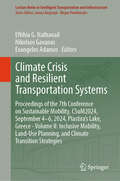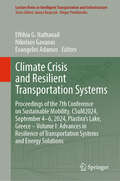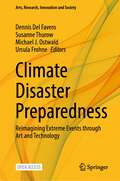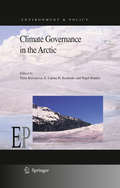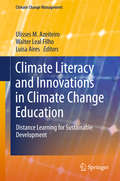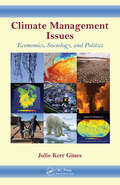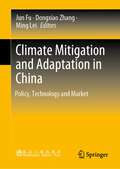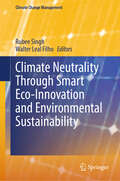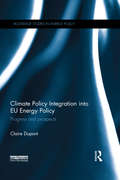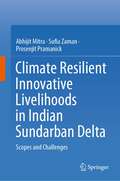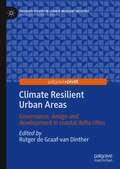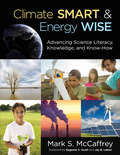- Table View
- List View
Climate Crisis and Resilient Transportation Systems: Proceedings of the 7th Conference on Sustainable Mobility, CSuM2024, September 4–6, 2024, Plastira’s Lake, Greece - Volume II: Inclusive Mobility, Land-Use Planning, and Climate Transition Strategies (Lecture Notes in Intelligent Transportation and Infrastructure)
by Eftihia G. Nathanail Nikolaos Gavanas Evangelos AdamosThis book reports on original research and practical findings fostering collaborative, inclusive, just, safe and climate neutral transportation planning. Being the second volume of the proceedings of the 7th Conference on Sustainable Mobility (CSuM 2024), held on September 4–6, 2024, at Plastira’s Lake, Greece, it describes state-of-the-art models, techniques, and applications that enable the transition of transportation systems to support sustainable societies. All in all, this book offers extensive information to academicians, researchers, practitioners and decision makers working on effective strategies to transform mobility in a sustainable and equitable way.
Climate Crisis and Resilient Transportation Systems: Proceedings of the 7th Conference on Sustainable Mobility, CSuM2024, September 4–6, 2024, Plastira’s Lake, Greece – Volume I: Advances in Resilience of Transportation Systems and Energy Solutions (Lecture Notes in Intelligent Transportation and Infrastructure)
by Eftihia G. Nathanail Nikolaos Gavanas Evangelos AdamosThis book reports on original research and practical findings fostering resilient and sustainable transportation systems in response to the climate crisis. Being the first volume of the proceedings of the 7th Conference on Sustainable Mobility (CSuM 2024), held on September 4–6, 2024, at Plastira’s Lake, Greece, it focuses on research and practical strategies for developing sustainable and resilient transportation systems, and guidance for their green and digital transition. All in all, this book offers extensive information to academicians, researchers, practitioners and decision makers working on effective strategies to enhance resilence of transportation systems.
Climate Crisis and Sustainable Solutions: Strategies for Adaptation, Mitigation and Sustainable Development
by S. Ananda Babu Narpinder SinghThis contributed volume dives into the critical intersection of climate adaptation, vulnerability to hazards, and the imperative of decarbonization in fortifying global food and nutritional security. This comprehensive exploration aims to shed light on the challenges our food systems face in the wake of climate change, and the strategies required to ensure resilience and sustainability. In the face of escalating climate challenges, securing sustenance demands a comprehensive approach. Climate adaptation becomes paramount, as agricultural systems struggle with increased vulnerabilities to various hazards. From extreme weather events to shifting precipitation patterns, the agricultural landscape is under constant threat. The decarbonization imperative emerges as a critical strategy, addressing the dual goals of mitigating climate change and enhancing food and nutritional resilience. By reducing carbon emissions and transitioning to sustainable practices, we not only contribute to global climate goals but also fortify food systems against environmental shocks. This integrated approach acknowledges the intricate connections between climate, agriculture, and nutrition, emphasizing the urgency of concerted efforts to ensure a resilient and sustainable future for food production and consumption. This book includes in-depth case studies from different regions, showcasing the diverse impacts of climate change on food systems. This book will integrate insights from multiple disciplines such as environmental science, agriculture, policy studies, and community engagement, providing a more holistic understanding of the issues at hand. It will serve as a valuable resource for students, researchers and practitioners seeking in-depth knowledge on these interconnected topics.
Climate Disaster Preparedness: Reimagining Extreme Events through Art and Technology (Arts, Research, Innovation and Society)
by Michael J. Ostwald Ursula Frohne Dennis Del Favero Susanne ThurowAs a result of global warming, extreme events, such as firestorms and flash floods, pose increasingly unpredictable and uncertain existential threats, taking lives, destroying communities, and wreaking havoc on habitats. Current aesthetic, technological and scientific frameworks struggle to imagine, visualise and rehearse human interactions with these events, hampering the development of proactive foresight, readiness and response.This open access book demonstrates how the latest advances in creative arts, intelligent systems and climate science can be integrated and leveraged to transform the visualisation of extreme event scenarios. It reframes current practice from passive perception of pre-scripted illustrations to active immersion in evolving life-like interactive scenarios that are geo-located. Drawing on the multidisciplinary expertise of leaders in the creative arts, climate sciences, environmental engineering, and intelligent systems, this book examines the waysin which climate disaster preparedness can be reformulated through practices that address dynamic and unforeseen interactions between climate and human life worlds. Grouped into four sections (picturing, narrating, rehearsing, and communicating), this book maps this approach by exploring the emerging strengths and current limitations of each discipline in addressing the challenge of envisioning the unpredictable interaction of extreme events with human populations and environments. This book provides a timely intervention into the global discourse on how art, culture and technology can address climate disaster resilience. It appeals to readers from multiple fields, offering academic, industry and community audiences novel insights into a profound gap in the current knowledge, policy and action landscape.
Climate Emergency – Managing, Building , and Delivering the Sustainable Development Goals: Selected Proceedings from the International Conference of Sustainable Ecological Engineering Design for Society (SEEDS) 2020
by Mohammad Dastbaz Christopher Gorse Colin Booth Lloyd ScottThrough research and proven practice, the aim of the International Conference of Sustainable Ecological Engineering Design for Society (SEEDS) is to foster ideas on how to reduce negative impacts on the environment while providing for the health and well-being of society. The professions and fields of research required to ensure buildings meet user demands and provide healthy enclosures are many and diverse. The SEEDS conference addresses the interdependence of people, the built and natural environments, and recognizes the interdisciplinary and international themes necessary to assemble the knowledge required for positive change.
Climate Friendly Goods and Technologies in Asia: Opportunities for Trade (SpringerBriefs in Environmental Science)
by Soumyananda Dinda<p>This book investigates the potential trade opportunity of climate friendly goods and technology (CFGT) in Asia and South Asia region, and uses a case study of India to clarify India's position on global warming and efforts to mitigate climate change impacts regionally and globally. In four main sections, the book applies econometric techniques to analyze the trade performance of CFGTs in nations in Asia and South Asia, in order to assess trade gaps and map the movement of CFGTs in these regions. The major themes addressed in the book include climate change and trade, issues that shape regional and national policies, and strategies for implementing global climate change mitigation on trade opportunities and developments. <p>Section 1 introduces readers to some background on global climate change threats and its effects on trade, as well as the need to develop trade for CFGTs. Section 2 assesses the trade performance of CFGTs in Asia, and South Asia, and the competitiveness of CFGT trade. Section 3 uses a regional orientation index to analyze CFGT trade. Section 4 discusses the potential business applications of CFGT trade in the Asia, South Asia region, and uses a case study on India to analyze climate change mitigation effects on trade and policy. The book will be of interest to researchers, students, governments, and policy makers.</p>
Climate Governance in the Arctic (Environment & Policy #50)
by E. Carina Keskitalo Nigel Bankes Timo KoivurovaClimate change is affecting the Arctic environment and ecosystems at an accelerating speed, twice the rate of the global average. This is opening the Arctic to transportation and resource development and creating serious challenges for local communities and indigenous peoples. Climate Governance in the Arctic considers two aspects of climate change from an institutional perspective. It focuses on how relevant regimes, institutions and governance systems support mitigation of climate change. It also examines the extent to which the varying governance arrangements in the Arctic support adaptation and the development of adaptation processes for the region. The book's focus on Arctic governance offers unique insights within climate change mitigation and adaptation research.
Climate Impacts on Agricultural and Natural Resource Sustainability in Africa
by Rattan Lal Bal Ram Singh Lars Olav Eik Andy Safalaoh Nyambilila A. Amuri Bishal K. SitaulaThis book discusses knowledge-based sustainable agro-ecological and natural resource management systems and best practices for sustained agricultural productivity and ecosystem resilience for better livelihoods under a changing climate. With a focus on agriculture in Africa, the book assesses innovative technologies for use on smallholder farms, and addresses some of the key Sustainable Development Goals to guide innovative responses and enhanced adaptation methods for coping with climate change.Contributions are based on 'Capacity Building for Managing Climate Change in Malawi' (CABMACC), a five-year program with an overall goal to improve livelihoods and food security through innovative responses and enhanced capacity of adaptation to climate change. Readers will discover more about sustainable crop production, climate smart agriculture, on-farm energy supply from biogas and the potential of soil carbon sequestration in crop-livestock systems.
Climate Intervention: Carbon Dioxide Removal and Reliable Sequestration
by Committee on Geoengineering Climate: Technical Evaluation Discussion Of ImpactsThe signals are everywhere that our planet is experiencing significant climate change. It is clear that we need to reduce the emissions of carbon dioxide and other greenhouse gases from our atmosphere if we want to avoid greatly increased risk of damage from climate change. Aggressively pursuing a program of emissions abatement or mitigation will show results over a timescale of many decades. How do we actively remove carbon dioxide from the atmosphere to make a bigger difference more quickly? As one of a two-book report, this volume of "Climate Intervention" discusses CDR, the carbon dioxide removal of greenhouse gas emissions from the atmosphere and sequestration of it in perpetuity. "Climate Intervention: Carbon Dioxide Removal and Reliable Sequestration" introduces possible CDR approaches and then discusses them in depth. Land management practices, such as low-till agriculture, reforestation and afforestation, ocean iron fertilization, and land-and-ocean-based accelerated weathering, could amplify the rates of processes that are already occurring as part of the natural carbon cycle. Other CDR approaches, such as bioenergy with carbon capture and sequestration, direct air capture and sequestration, and traditional carbon capture and sequestration, seek to capture CO2 from the atmosphere and dispose of it by pumping it underground at high pressure. This book looks at the pros and cons of these options and estimates possible rates of removal and total amounts that might be removed via these methods. With whatever portfolio of technologies the transition is achieved, eliminating the carbon dioxide emissions from the global energy and transportation systems will pose an enormous technical, economic, and social challenge that will likely take decades of concerted effort to achieve. "Climate Intervention: Carbon Dioxide Removal and Reliable Sequestration" will help to better understand the potential cost and performance of CDR strategies to inform debate and decision making as we work to stabilize and reduce atmospheric concentrations of carbon dioxide.
Climate Literacy and Innovations in Climate Change Education: Distance Learning for Sustainable Development (Climate Change Management)
by Walter Leal Filho Ulisses M. Azeiteiro Luísa AiresThis book addresses the links between climate change and the threats it poses to sustainable development, from a distance education perspective. Discussing current trends and challenges in sustainable development education, climate literacy and innovations in climate change education, it contributes to the global debate on the implementation of education for sustainability. It also assesses the role that e-learning can play in this process, addressing pedagogical concepts as well as the wide range of technological options now available.
Climate Management Issues: Economics, Sociology, and Politics
by Julie K. GinesDespite all the controversy and hype that climate change has generated, there now exists an overwhelming body of scientific evidence that the problem is real and that its effects are already being felt on a global scale. Part of what makes this a volatile and controversial issue is that it is not just confined to the realms of the scientific commun
Climate Mitigation and Adaptation in China: Policy, Technology and Market
by Jun Fu Dongxiao Zhang Ming LeiClimate change is a huge challenge to humanity in the 21th century. In view of China’s recent pledge to the international community to peak carbon emissions before 2030 and achieve carbon neutrality by 2060, this book examines climate mitigation and adaptation efforts in China through the prism of the steel sector, and it does so from three interrelated perspectives, i.e., policy, technology, and market. The book argues that in developing the country’s strategy towards green growth, over the years there has been a positive and interactive relationship between China’s international commitments and domestic agenda setting in mitigation and adaptation to the impact of climate change. To illustrate China’s efforts, two special areas, i.e., carbon capture, utilization and storage (CCUS) and emissions-trading system (ETS), have received focused examination. Along the spectrum of low-carbon, zero-carbon, and negative-carbon strategies, this study ends with a simulation model which outlines different policy scenarios, challenges, and uncertainties, as China moves further on, trying to achieve carbon neutrality in 2060. The book will be of interest to scholars, policy-makers, and business executives who want to understand China’s growing role in the world.
Climate Neutral and Resilient Farming Systems: Practical Solutions for Climate Mitigation and Adaptation (Earthscan Food and Agriculture)
by Udaya Sekhar NagothuThis book presents evidence-based research on climate-neutral and resilient farming systems and further to provide innovative and practical solutions for reducing greenhouse gas emissions and mitigating the impact of climate change. Intensive farming systems are a significant source of greenhouse gas emissions, thereby contributing to global warming and the acceleration of climate change. As paddy rice farming is one of the largest contributors, and most environmentally damaging farming systems, this will be a particular focus of the book. The mitigation of greenhouse gas emissions needs to be urgently addressed to achieve the 2 degrees Celsius target adopted by COP21 and the 2015 Paris Agreement, but this is not possible if local and national level innovations are not accompanied by international level cooperation, mutual learning and sharing of knowledge and technologies. This book, therefore, brings together international collaborative research on climate-neutral and resilient farming systems compiled by leading scientists and experts from Europe, Asia and Africa. The chapters present evidence-based research and innovative solutions that can be applied or upscaled in different farming systems and regions across the world. Chapters present models and technologies that can be used for practical implementation at the systemic level and advance state of the art knowledge on carbon neutral farming. Combining theory and practice, this interdisciplinary book provides guidance which can inform and increase cooperation between researchers from various countries on climate-neutral and resilient farming systems. Most importantly, the volume provides recommendations which can be put into practice by those working in the agricultural industry, especially in developing countries, where they are attempting to promote climate-neutral and resilient farming systems. The book will be of great interest to students and academics of sustainable agriculture, food security, climate mitigation and sustainable development, in addition to policymakers and practitioners working in these areas.
Climate Neutrality Through Smart Eco-Innovation and Environmental Sustainability (Climate Change Management)
by Walter Leal Filho Rubee SinghThis book discusses how the relationship between climate neutrality, smart eco-innovation, and environmental sustainability can be understood as well as possible with an emphasis on relevant matters and challenges of a sustainable environment. It describes a framework for implementing climate resilient sustainable development, adaptation, and mitigation actions to achieve climate neutrality and the development of smart eco-innovations from the perspective of social, economic, and environmental aspects. The issue of climate neutrality is a critical one, and there are serious concerns about it. It is of great importance to understand the mechanism of climate change movement and climate variability, which also requires monitoring from a regional perspective in order to understand and mitigate climate change. The growing threat of climate instability requires smart and resilient policies in order to deal with it. Several analytical and practical approaches are available to promote resilience and environmental sustainability in all areas, encompassing the latest trends, developments, and useful tools including those related to the environment, sustainability, and climate change in rural, urban, and hilly areas. As the population of the world has increased rapidly, there is a great need for a more comprehensive understanding of the relationship between climate neutrality, smart eco-innovation, and environmental sustainability in addition to an urgent need for an effective and constructive mechanism to protect human lives and properties against threats to their lives and property that are anticipated or expected. This book is of interest and use to academicians, researchers, scientists, environmentalists, land resource managers, climate change scientists, forest administrators, but it is also of use to academicians, researchers, scientists, and scientists. In addition, this book also serves as a valuable resource for researchers and students in agriculture, ecology, soil science, and environmental science. This is also going to prove to be a useful read for policymakers as well.
Climate Policy Integration into EU Energy Policy: Progress and prospects (Routledge Studies in Energy Policy)
by Claire DupontClimate change is a cross-cutting, long-term, global problem that presents policymakers with many challenges in their efforts to respond to the issue. Integrating climate policy objectives into the elaboration and agreement of policy measures in other sectors represents one promising method for ensuring coherent policies that respond adequately to the climate change challenge. This book explores the integration of long-term climate policy objectives into EU energy policy. It engages in-depth empirical analysis on the integration of climate policy objectives into renewable energy policy; energy performance of buildings; and policies in support of natural gas importing infrastructure. The book describes insufficient levels of climate policy integration across these areas to achieve the long-term policy goals. A conceptual framework to find reasons for insufficient integration levels is developed and applied. This book is a valuable resource for students, researchers, academics and policymakers interested in environmental, climate change and energy policy development in the EU, particularly from the perspective of long-term policy challenges. The book adds to scholarly literature on policy integration and EU integration, and contributes to new and developing research about EU decarbonisation.
Climate Protection and Environmental Interests in Renewable Energy Law: Perspectives from Brazil and Germany
by Paula Galbiatti SilveiraThis book is about environmental and climate legal protection in the energy transition. The Paris Agreement has a binding commitment of holding the global temperature increase to 2°C while pursuing efforts to limit it to 1.5°C. To cope with the negative effects of climate changes and mitigate greenhouse gas emissions, one of the primary responses has been the deployment of renewable energy sources, transiting from fossil fuels to sustainable electricity production. However, renewable energy sources can also cause significant environmental impacts. Wind energy, for instance, can impact biodiversity, such as birds and bats, killing them when colliding with turbines and affecting their migration and nesting.This results in conflicts in environmental law. This book questions whether, in the energy transition, the generation of electricity from renewable sources to protect the climate is compatible with the protection of the environment, both interests in environmental law.To address this question, this book follows a legal-environmental perspective and assesses the common problem of solving those internal environmental conflicts in Brazilian and German law to understand and compare whether and how both legal systems solve the conflicts by compatibilizing the protection of the climate with other environmental interests. The legal analysis focuses on land-use planning and environmental licensing, assessing similarities and differences, and evaluating the results, identifying what one country can learn from the other.
Climate Resilience and Environmental Sustainability Approaches: Global Lessons and Local Challenges
by S. D. Attri Anubha Kaushik C. P. KaushikThe book is about climate resilience and environmental sustainability approaches, discussing knowledge at global level and the local challenges, presented by authors from various countries. Environmental sustainability is at stake and implications of climate change are clearly visible in most parts of the world. In the times of the prevailing global environmental crisis, this book discusses key issues of climate change and sustainable energy alternatives, waste management and development. It discusses climate change scenario using simulation models in various Asian countries, signatures of climate change in Antarctica, implications in the Indian Ocean and the Indian scenario of REDD+. A special focus has been given on building climate resilience in our agricultural ecosystems and sustainable agriculture. It discusses the prospects and challenges of renewable energy options including biofuels and energy from wastewaters, explores the technical aspects of eco-friendly bioremediation of pollutants, sustainable solid waste management practices and challenges, carbon footprints of industry, and emphasizes on the significance of combining traditional knowledge with modern technology with novel approaches including involvement of social enterprises and corporate social responsibility to achieve the Sustainable Development Goals. This is an important document for researchers and policy makers working in multidisciplinary fields of sustainability sciences.
Climate Resilient Agriculture for Ensuring Food Security
by P. Parvatha ReddyClimate Resilient Agriculture for Ensuring Food Security comprehensively deals with important aspects of climate resilient agriculture for food security using adaptation and mitigation measures. Climatic changes and increasing climatic variability are likely to aggravate the problem of future food security by exerting pressure on agriculture. For the past few decades, the gaseous composition of the earth's atmosphere has been undergoing significant changes, largely through increased emissions from the energy, industry and agriculture sectors; widespread deforestation as well as fast changes in land use and land management practices. Agriculture and food systems must improve and ensure food security, and to do so they need to adapt to climate change and natural resource pressures, and contribute to mitigating climate change. Climate-resilient agriculture contributes to sustainably increasing agricultural productivity and incomes, adapting and building resilience to climate change and reducing and/or eliminating greenhouse gas emissions where possible. The information on climate resilient agriculture for ensuring food security is widely scattered. There is currently no other book that comprehensively and exclusively deals with the above aspects of agriculture and focuses on ensuring food security. This volume is divided into fourteen chapters, which include the Introduction, Causes of Climate Change, Agriculture as a Source of Greenhouse Gases, Impacts of Climate Change on Agriculture, Regional Impacts on Climate Change, Impacts on Crop Protection, Impacts on Insect and Mite Pests, Impacts on Plant Pathogens, Impacts on Nematode Pests, Impacts on Weeds, Impacts on Integrated Pest Management, Climate Change Adaptation, Climate Change Mitigation, and A Road Map Ahead. The book is extensively illustrated with excellent photographs, which enhance the quality of publication. It is clearly written, using easy-to-understand language. It also provides adoptable recommendations involving eco-friendly adaptation and mitigation measures. This book will be of immense value to the scientific community involved in teaching, research and extension activities. The material can also be used for teaching post-graduate courses. It will also serve as a very useful reference source for policy makers.
Climate Resilient Innovative Livelihoods in Indian Sundarban Delta: Scopes and Challenges
by Abhijit Mitra Sufia Zaman Prosenjit PramanickThis book covers several innovative alternative livelihoods based on mangrove floral resources with their respective SWOT analysis. True mangrove flora and their associates in Indian Sundarbans are noted for their wide spectrum of ecosystem services in which livelihoods of the region are one of the most important components. Many alternative mangrove-centric livelihoods are in the pipeline of startup. However, due to difficulty in marketing and lack of clarity over ownership of natural resources, the values of the mangrove-based products have not been fully realized. Natural resources of several categories in Indian Sundarbans like oysters, seaweeds, medicinal mangrove flora, vitamin-rich mangrove fruits, etc. are still lying untapped. These untapped resources have been spun with the livelihood sectors of the Sundarban people backed up with sound business models to make the venture sustainable. The carbon foot prints associated with each of these livelihoods have been studied in details and steps have been suggested for net zero carbon livelihood programmes along with their sustainability. The book provides the readers about several mangrove-based cutting-edge researches and technologies in the domain of climate resilient livelihood, which if implemented can lead to food and economic security of the region.
Climate Resilient Sustainable Agriculture
by Kodoth Prabhakaran NairThe principal focus of this book will be how to make agriculture/food production climate resilient in the ecologically sensitive zones. The Western Ghats, in the state of Kerala, India, in which Wayanad district falls, has 75% of its area classified as ecologically sensitive zones and there are three types of such zones: (1)Highly ecologically sensitive zones (2) Middle sensitivity zones and (3) Low sensitivity zones. Most of the construction has taken place in the first two categories, and, indiscriminate and intense quarrying has also taken place in these two zones. As aerosol load increases in the atmosphere, dust particles from rock quarries increases which leads to higher ambient temperature, leading to ocean warming in the Arabian ocean, finally, resulting in excessive cloud formation and consequent torrential rainfall. This has led to huge landslides, where more than 500 human lives were lost in addition to huge property loss making it a global disaster of immense proportions. The book highlights the crucial question how agriculture in these sensitive areas can be made climate resilient.
Climate Resilient Urban Areas: Governance, design and development in coastal delta cities (Palgrave Studies in Climate Resilient Societies)
by Rutger de Graaf-van DintherThis book describes the urgent challenge faced by cities worldwide to become resilient to climate change impacts. This challenge goes further than the ability to resist the impacts of extreme weather conditions. Coping with climate impacts and the ability to recover from them are equally important, as well as the capacity to adapt to the effects of climate change and the ability to transform the entire urban system. The book explores how the resilience journey for coastal cities in particular encompasses using scientific knowledge but also the knowledge of citizens and practitioners. Measures and strategies on different scales are needed, from national scale all the way down to neighbourhood, street level and building level. Representing the holistic nature of climate resilience, this collection contains unique insights from leading scientists and practitioners in areas of expertise such as engineering, social sciences and urban design. It will be a valuable resource for scholars, students, practitioners and policy makers interested in the development of resilient and sustainable urban environments.
Climate Resilient, Green and Low Carbon Built Environment (Green Energy and Technology)
by Ashok Kumar JainThis book constitutes state-of-the-art research covering a wide range of topics including climate change and carbon emissions, air quality and pollution control, urbanism, land and circular economy, sustainable transport, energy, water, biodiversity and greenery, environmental services, housing, and construction with respect to the built environment. The concepts of sustainability in built environment conclude with reimagining the city. The content includes pedagogical features such as examples, simple flowing language and over 100 figures. The book aims to motivate architects, engineers, consultants, builders, and planners to respond to the challenges of sustainability in the built environment.
Climate Risk Management in Agriculture: Monthly and Seasonal Forecast Application
by U. C. Mohanty Palash Sinha M. M. Nageswara Rao Dillip Kumar Swain K. K. SinghSustainable agricultural production is vital for food security and agricultural productivity. It is greatly influenced by weather and climate conditions. This book focuses on understanding weather and climate systems and crop yield productions, including integrated weather-crop prediction systems for climate risk management in agriculture. It examines the impact of climate change and its variability on different crops, and possible ways to minimize the loss for farmers. This book also describes different weather and climate hazards, including the fundamentals of weather/climate prediction systems and numerical weather prediction (NWP) models. It presents the need for seamless weather/climate predictions and their impact on agriculture. The status and availability of different monthly and seasonal scale forecasts worldwide is explored and how the forecasting models or products can be evaluated using statistical methods. The book concisely elucidates systematic model bias removal techniques and a reliable approach based on multi-statistics in producing a single forecast from the multi-model grand ensemble. Since crop models need daily weather sequence, several standard disaggregation methods for generating daily weather sequences from monthly/seasonal products are presented. This book describes several aspects that are needed for agricultural practices and crop modelling. It encapsulates different components of crop models and their application, preparation methods of Crop Weather Calendar, application of disaggregated weather sequence in crop models, and generation of Climate Risk Matrices (CRM). A detailed methodology is presented for hands-on practice, including downloading and processing data, model evaluation and bias corrections, generating a single forecast, disaggregation, and preparing CRM based on crop model products. This book contains a total 11 chapters and appeals to students, researchers, scientists, and operational agencies.
Climate Risks to Water Security: Framing Effective Response in Asia and the Pacific (Palgrave Studies in Climate Resilient Societies)
by Hemant Ojha Nicholas Schofield Jeff CamkinIn Asia and the Pacific, climate change is now a well-recognised risk to water security but responses to this risk are either under reported, or continue to be guided by the incremental or business as usual approaches. Water policy still tends to remain too narrow and fragmented, compared to the multi-sectoral and cross-scalar nature of risks to water security. What’s more, current water security debates tend to be framed in discipline specific or academic ways, failing to understand decision making and problem-solving contexts within which policy actors and partitioners have to operate on a daily basis. Much of the efforts to date has focussed on assessing and predicting the risks in the context of increasing levels of uncertainty. There is still limited analysis of emerging practices of risks assessment and mitigation in different contexts in Asia and the Pacific.Going beyond the national scales and focussing on several socio-ecological zones, this book captures stories written by engaged scholars on recent attempts to develop cross-sectoral and cross-scaler solutions to assess and mitigate risks to water security across Asia and the Pacific. Identifying lessons from successes and failures, it highlights management and strategic lessons that water and climate leaders of Asia and the Pacific need to consider. This book showcases reflective and analytical thought pieces written by key actors in the climate and water spaces. Several critical socio-ecological zones are covered – from Pakistan in the west to pacific islands in the east. The chapters clearly identify strategies for improvement based on the analysis of emerging responses to climate risks to water security and gaps in current practices. The book will include an editorial introduction and a final synthesis chapter to ensure clear articulation of common themes and to highlight the overall messages of the book.
Climate Smart & Energy Wise: Advancing Science Literacy, Knowledge, and Know-How
by Mr Mark S. McCaffreyToday’s answers to our most urgent climate issues The twenty-first century ushered in a set of unmistakably urgent global challenges that are too important to be an afterthought in today’s classrooms. Climate Smart & Energy Wise offers a virtual blueprint to climate and energy education, packed with resources and strategies, including: A high-level overview of where climate and energy topics fit (or don't fit) into your current curriculum with connections to the NGSS Proven methods to teach climate change and related topics in a grade-appropriate way Sample learning activities and high-quality online resources
